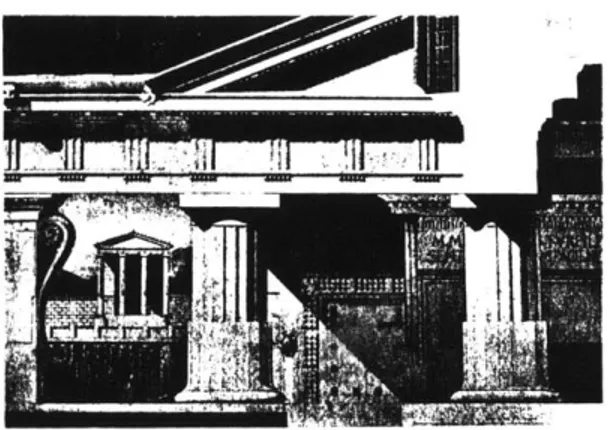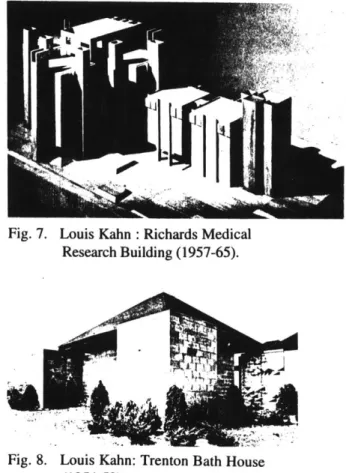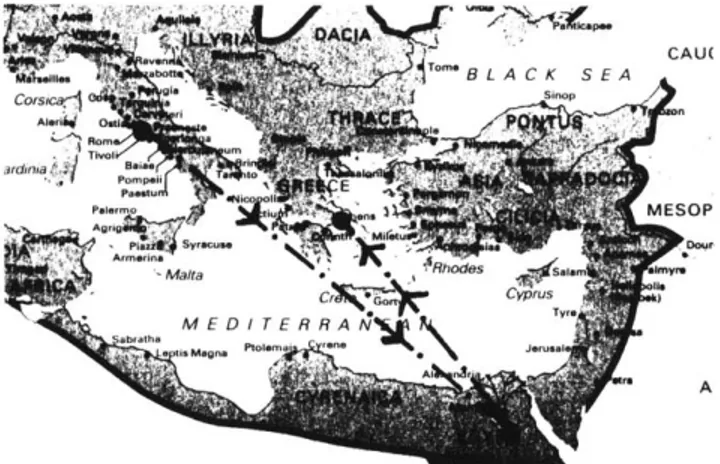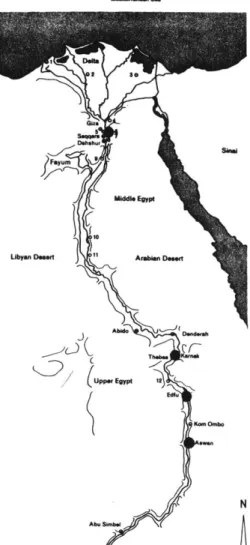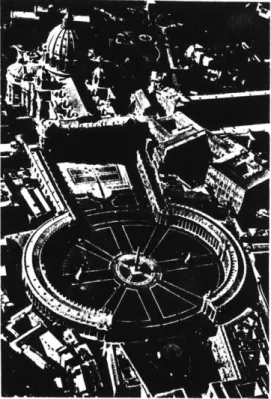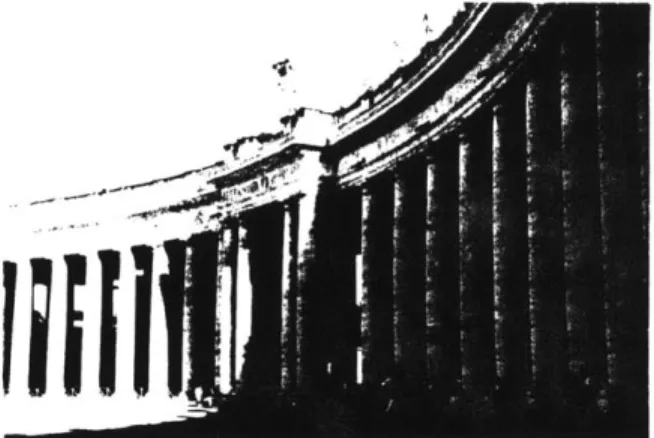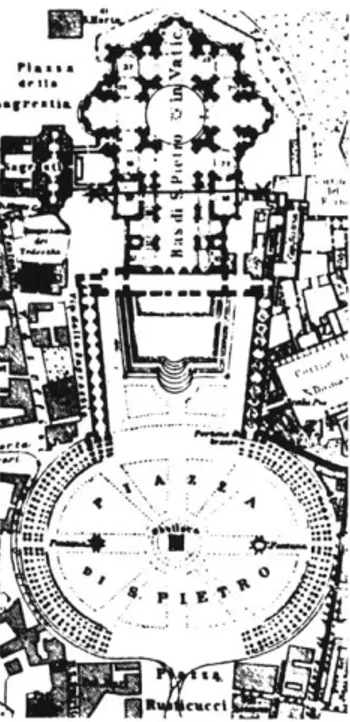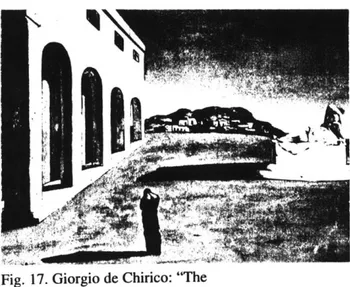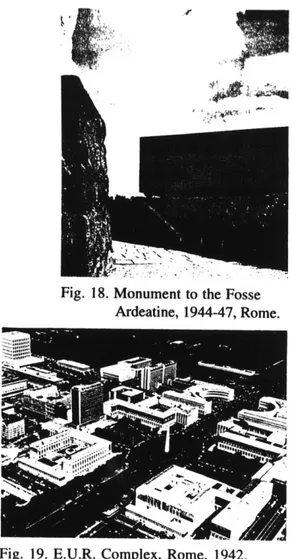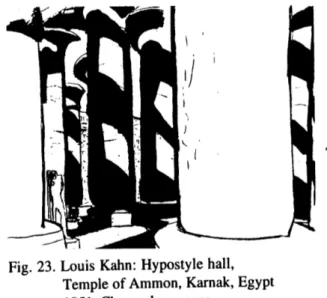Dialectics of Vision :
The Voyages of Louis I. Kahn 1950-59
ByAdnan Zillur Morshed
Bachelor of Architecture
Bangladesh University of Engineering and Technology Dhaka, Bangladesh
March, 1991
Submitted to the Department of Architecture
in Partial Fulfillment of the Requirements for the Degree of Master of Science in Architecture Studies
at the
MASSACHUSETTS INSTITUTE OF TECHNOLOGY May, 1995
@ 1995 Adnan Zillur Morshed
All rights reserved
The author hereby grants to M.I.T. permission to reproduce and to distribute publicly paper and electronic copies of this thesis document in whole or in part.
A
A ASignature of Author
Adnan Zillur Morshed Department of Architecture May 12, 1995
Certified by
Professor Stanford Anderson Professor of History and Architecture Head of the Department Thesis Supervisor
Accepted by
MiASSAC'HUSETTS INSTITUTE
OF TECHNOLOGY
Professor Roy Strickland Chairman Departmental Committee on Graduate Students
JUL 2
5
1995
MITLibraries
Document Services Room 14-0551 77 Massachusetts Avenue Cambridge, MA 02139 Ph: 617.253.2800 Email: docs@mit.edu http://libraries.mit.edu/docsDISCLAIMER OF QUALITY
Due to the condition of the original material, there are unavoidable
flaws in this reproduction. We have made every effort possible to
provide you with the best copy available. If you are dissatisfied with
this product and find it unusable, please contact Document Services as
soon as possible.
Thank you.
Both the Archives and Library copies of this thesis contain poor grayscale
image reproductions. This is the best copy available.
Dialectics of Vision:
The Voyages of Louis I. Kahn 1950-59
by Adnan Zillur Morshed
Submitted to the Department of Architecture on May 12, 1995 in partial fulfillment of the requirements for the degree of Master of Science in Architecture Studies.
Abstract:
Kahn's genre of travel sketches offers us a visual basis to map his philosophical
meandering. This thesis addresses the sketches produced from Kahn's voyages around the mediterranean in 1950-51 and 1959 with an aim to understanding the premises that underlie them. During the trips, Kahn conjectured in his graphic oeuvre a dialogical method with the built forms of antiquity. On the one hand, he sought answers to his architectural and
epistemological questions to these buildings; at another level, he recontextualized the buildings in an imagined landscape that would in turn inform his imperatives. The sketches also permit an interesting theoretical commentary as they parallel Kahn's emergence into active architectural career in the fifties. At first encounter, some of them seem to be perplexing, but once extended into the context in which Kahn operated, they reveal an interwoven terrain of concepts that would continuously flower.
There is no doubt that in his travel sketches Kahn was fighting a protracted battle about his architecture and that he benefited from the buildings of the past-but mostly at an
epistemological level. Kahn raised questions on architecture that could have not been addressed by a formal retrieval of history. In that sense Kahn's travel sketches reappraise and repropose the lessons of history.
Thesis Supervisor: Stanford Anderson Title: Professor of History and Architecture
C
ON
T
EN
T
ABSTRACT
3
ACKNOWLEDGMENT
7
CHAPTER ONE
9
Introduction
Existing Approaches to Kahn's Travel Sketches Kahn: 1930s and 1940s
CHAPTER TWO
33
Kahn and the Sketch
American Academy in Rome Inside Kahn's Sketches :
The Italian Piazzas 1950-51 The Egyptian Monuments The Athenian Acropolis
Carcassonne, Albi and Ronchamp 1959
CHAPTER THREE
75
Reflections : Light
The 'Mythical' Landscape The Elemental Perception Kahn's Travel Sketch and Architecture Epilogue
BIBLIOGRAPHY 110
Acknowledgements
First of all, I must acknowledge that I had a solid thesis committee, consisting of professors Stanford Anderson, Francesco Passanti and Royston Landau. Working
with them has been a truly enlightening experience, both in the context of this particular topic and the intellectual trajectories beyond. I would like to express my
sincerest gratitude to them.
From Professor Anderson, my thesis advisor, I learned how to raise the right question at the right time. As I pursued my research, I realized that that is the most important thing in any critical investigation. I am extremely grateful to him for his insightful criticism, personal warmth and continuous support. Having worked with him, I grew an appetite for knowledge, which will be an asset for the rest of my life.
Working with Professor Passanti was a sheer act of enlightenment. I just do not know how to be thankful to him, because nothing will I say would reflect what I feel. I will just mention that his thoughtful criticism, tactical advise and, most of all, his personal engagement would be one of the most memorable experiences of my life.
With Professor Landau I learned how to build an argument through continuous self-questioning, which I thought was extremely important. He shared his
experiences with Kahn with me, which helped me see Kahn from different angles. His encouragement kept my morale high during the course of the thesis. I owe him my sincerest thanks.
I am indebted to Professor Attilio Petruccioli for reasons too innumerable to
mention. He was always there when I needed him. I am very grateful to Professor Henry Millon for helping me identify the right questions at the outset of my research on Kahn. I wish to thank Professors William Porter and Nasser Rabbat and architect Harry Portnoy for their support on many occasions.
I also wish to express my sincere gratitude to:
Sarah Ksiazek at UT Austin, for letting me read part of her doctoral dissertation and allowing me some wonderful telephone conversations that helped me build my argument;
David Brownlee at U Penn, for giving me many advices at the formative stage of this thesis;
Anne Tyng at Philadelphia, for clarifying some of my ideas on Kahn; Jan Hochstim in Miami, for giving me many valuable information from his experiences with Kahn;
Julia Moore Converse at the Kahn Collection in Philadelphia, for helping me find what I needed;
Sue Ann Kahn in New York, for sharing with me some of her memoir of her father;
Khaled Ashraf at U Penn, for giving me many insights; Annie Pedret at MIT, for her encouragement.
Finally, I wish to express my deepest gratitude to:
the Department of Architecture at MIT, for awarding me the Schlossman Research Fellowship 1994-95, which made my research at the Louis I. Kahn Collection possible;
and, the Aga Khan Program at Harvard University and MIT for giving me the AKP Summer Travel Grant 1994, which helped me follow Kahn's itinerary around the mediterranean.
Chapter
CHAPTER ONE
Introduction:
Voyages to the sites of classical antiquity, for instance, those undertaken
by Le Corbusier or Louis Kahn, in spite of the fact that they certainly
correspond to a pedagogical legacy of the "Grand Tour" which from the Renaissance through Ecole des Beaux-Arts codified the examination and measurement of the classical buildings as critical learning of an architect, nonetheless represented an experience of individual initiation. The travel sketch is not only the embodiment of an individual response towards certain phenomena but also the conjecture of a premise/idea seeking objectives beyond the physical periphery of the phenomena. Hence, the representation of the same object/artifact in the travel sketches increasingly became varied. The transferals and interpretations which result from them constitute larger discourses beyond technical expediency. In his visit to the Athenian Acropolis during his 1911 "voyage d'orient," Corbusier's vision culminates in a resplendent image of the Parthenon itself, envisaged as the "pure creation of the mind."' (Fig.1) Interestingly, in Kahn's representation of the same site in 1951, the Acropolis assumes instead a holistic
Le Corbusier. Toward a New Architecture. trans. Frederick Etchells (Praeger Publishers,
Fig. 1. Le Corbusier: The Parthenon, 1911.
quality in a dialogue between its bulwark and the surrounding rocky terrain.(Fig.2) To Corbusier the Parthenon becomes exemplary for the creative process whereas Kahn's Parthenon is a constituent part of a "mythic" landscape.
Why does the same place evoke such diverse images? The answer lies partially in the fact that each beholder has his or her own agenda in responding to a place or a built form. As Walter Benjamin noted in his
Moscow Diary, neither a singular point of view nor a linear approach
can claim the authority to establish knowledge of a place.2 The travel sketch can, then, very much become reflective of individual perception and objectives.
From this perspective, a premise-the sketch as a critical translation-could be developed. One can argue that the distance between the "real" subject and the sketch, as a mediated construction, becomes long. Long not in the sense of tangible polarities but in the sense of an ambiguous span of interpretability. Considering the act of sketching a translation from the subject to the sketch, analogous to the translation of languages, as opposed to the largely educative Fig. 2. Louis Kahn : The Acropolis, 1951
2 Kahn, Andrea, "Disclosure: Approaching Architecture," The Harvard Architectural
(prescriptive?) exploration of the Beaux-Arts analytique ,3 (Fig.3) a transmutation of meanings occurs in between. In his questioning the "Translations From Drawing To Building",4 Robin Evans has illuminated the point by proposing two possible options to define architectural drawing (i.e. the drawing of a proposed building) and then, by hypothesizing the impossibility of a translation from drawing to building without modulation. The first one is to surrender the claim to represent reality altogether and accept the drawing as a self-referential object without any communicative effect beyond itself. The second is to employ the communicative and transmittive properties of the drawing as a way of thinking about a future building with or through the drawing.
By broadening, and perhaps reversing the second paradigm in Robin Evans, the travel sketch could be viewed as a translation of an existing scene into a graphic representation where "meanings" do not
3 Following the examples set by the Renaissance architects, the students of the Ecole des Beaux-Arts recorded and presented in the form of a composite sheet or the analytique, their observations from the classical architecture. In The Study of Architectural Design, J. Harbeson gave a twofold definition of analitique: on one hand, "a study in proportion, and in the elements of architecture-the treatment of walls, doorways, windows, cornices, balustrades, porticos, arcades, etc." and on the other, a description of a drawing which composes multiple architectural aspects in one drawing. Also see Crowe, Norman "Visual Notes: Drawings that Link Observations with Design," Central (Winter 1986), pp. 5-14 4 Evans, Robin. "Translations from Drawing to Building," AA Files No. 12 (Summer
1986), pp. 3-18.
Fig. 3. John Harbeson, In The Study of
Architectural Design, provides
D'Espouy's Cori, Temple of Hercules
as an example of an analitique, showing plan and elevation at small scale, and
necessarily confront (or conform to) its putative subject; they may well be stemming from a relatively a priori construct that the person sketching brings, consciously or unconsciously, to the translatory motion.
Adopting this theoretical format for "sketch", this thesis addresses the hermeneutic significance of Louis Kahn's travel sketches produced during his travels. While his architectural oeuvre and textual productions inform us of his quest for an Order in architecture, this thesis, focusing "objectively" on his genre of travel sketches as a product by itself, attempts to map Kahn's mental meandering rendered graphically in the lines of charcoal, pastel or pen.
An idealist, searching always for his final destiny in the essence of things, Louis Kahn has been a lifelong voyager, both literal and symbolic-a fact marked first by the child Kahn's emigration in 1906 from the Baltic fringe of Estonia to Philadelphia along with his family and, finally, by his ironic death in 1974 in New York's Pennsylvania Station upon returning from Ahmedabad, India. In the meantime, however, apart from numerous long trips to India, Angola, Bangladesh, Israel etc., necessitated by some of his monumental commissions, Kahn undertook a good number of "voyages of discovery" to Italy,
France, England, Greece, Egypt etc. producing a fairly large body of graphic works.5
Kahn's artistic talents flourished from an early age. He received art lessons in public school and at the Graphic Sketch Club, which was part of Philadelphia's Public Industrial Art School. His talents were recognized when at the age of thirteen he won the first prize for drawing and painting in the John Wanamaker Children's Drawings Art Contest, and at the ages of eighteen and nineteen he was awarded first prize for best drawings in Philadelphia high schools by the Pennsylvania Academy of the Fine Arts.6 Like Corbusier,7 Kahn also
cherished and cultured all his life this artistic impulse to sketch.
Kahn's oeuvre of travel sketches spans over forty years and has three highlights. The first is a yearlong European voyage in 1928-29 having already received a degree in architecture under the tutelage of Paul Cret and having worked as a draftsman for Philadelphia city architect John Molitor.8 The second voyage occurred in 1950-51 when Kahn spent 5 For the most systematic and inclusive collection of Kahn's travel sketches see
Hochstim, Jan. The Paintings and Sketches of Louis I. Kahn. (Rizzoli, 1991).
6 Hochstim, Jan. The Paintings and Sketches of Louis L Kahn. p.19.
7 In an interview with Richard Saul Wurman printed in What Will Be Has Always Been:
The Words of Louis L Kahn. (Access & Rizzoli, 1986), Norman Rice recalled Corbusier's
lifelong fascination with the painting. p.294.
8 Brownlee, David B. and David G. De Long. Louis L Kahn: In the Realm of Architecture. (Rizzoli, 1991), p.2 2.
several months in Rome as the Architect in Residence at the American Academy and also went to Greece and Egypt. And finally, the trip in
1959 as Kahn made a detour to Carcassonne, Albi and Ronchamp in France when he went to present the keynote address at the Otterlo Congress in Holland.9
In the first trip, beginning from England, Kahn made his way through western as well as eastern Europe ending in Italy. Vincent Scully has characterized this period of Kahn's development as one of crisis and "intellectual dilemma": Kahn, trained under the Beaux-Arts curricula of the University of Pennsylvania, emerged during the late 20s into an architectural climate where its lessons were liked neither by most Beaux-Arts designers who opted for the structural rather than the eclectic side of the theory nor by the iconoclastic architects of the Modern Movement.'0 Referring to a traumatized Kahn finally finding his true 'destination' in classical architecture, Scully offered this succinct view:
9 Although technically this was the 11th CIAM, central to this congress was the agenda of the 'Team X'. Team X and the dissolution of CIAM have a complex historiography which is beyond the scope of this thesis. Hence, for convenience, in this thesis I will refer
to the 1959 meeting as the Otterlo Congress. For general reference about this congress, see Mumford, Eric "CIAM Urbanism After the Athens Charter", Planning Perspectives, 7
(1992). pp. 391-417, and Oosterman, Arjen and Rob Dettingmeijer "The Otterlo
Meeting", Rassegna 52 (1992), pp.8 2-8 7.
"...an artist who was educated in a clear if rather limited artistic tradition, developed in it, lost it, tried to adjust himself to a wholly different set of influences, apparently failed to do so, floundered," to finally find his way again in the 1950's when he "was free to go forward on his own at last." "
Although Scully's view received wide acceptance among scholars, there is no record of Kahn's actually speaking against modernism.'2 Much later in the 1950's, Kahn metaphorically described how he learned about the doctrines of the Modem Movement :
"Now when I got through the school, I walked around the realm and I came to a little village, and this village was very unfamiliar. There was nothing here that I had seen before. But through this unfamiliarity-from this unfamiliar thing-I realized what architecture was. Not right then, because I was then dealing with answers, but Le Corbusier raised the question for me, and the question is infinitely more powerful than the answer. So through the question-the power of it-the real thing was brought out."'3
Scully, Vincent J. "Marvelous Fountainheads: Louis I. Kahn, Travel Drawings", Lotus
International, (1991), No.68, p. 49.
12 De Long, David. "The Mind Opens to Realization", in Louis I. Kahn: In the Realm of
Architecture. p.51.
13 Kahn, keynote address at the Otterlo Congress, printed in Louis I. Kahn: Writings,
Lectures, Interviews. ed. Alessandra Latour (hereafter cited as Writings), (Rizzoli, New
Fig. 4. Louis Kahn: Amalfi coast, Italy,
1928-29,
Fig. 5. Louis Kahn: San Gimignano, Italy, 1929, Watercolor.
Stylistically, sketches from Kahn's first trip were visibly receptive to many contemporary movements in the art world, and embodied influences of many European as well as American masters including Henri Matisse, Cezanne, Raoul Dufy, John Marin and Georgia O'Keeffe. 4
(Fig.4) Despite this wide array of influences, one can trace some thematic developments within the body of the sketches from the first European trip, such as a consistent predilection for the vertical masses exemplified by the tower series of San Gimignano (Fig.5) and Assisi in Italy or Warwick Castle in England and again, the landscape series of Amalfi, Capri and Positano. (Fig.6) But the most persistent underlying theme is the play of light on the built environment.
But Kahn's more original works come from his second and third voyages around the mediterranean in 1950-51 and 1959. The significance (the reason this thesis addresses this time period) of the body of sketches resulting from these trips evolves from a number of issues. First, they parallel not only the gradual emergence of Kahn's active architectural career beginning with the Yale Art Gallery in
1951-53 but also the steady crystallization of his thought process' 5 since he
14 Scully, "Marvelous Fountainheads", pp.50-53.
"5 Since his first extended theoretical paper "Monumentality" in 1944, Kahn did not
produce any major paper until 1953 when Perspecta 2 published "Toward a Plan for Midtown Philadelphia." In 1956 the Pennsylvania Triangle, (vol.42, no.3) published "An Approach to Architectural Education." For general reference see Louis L Kahn:
became a visiting critic of design at Yale University in 1947. Second, one has to note that these sketches were coming from a committed architect witnessing an extremely "curious" decade for the architectural community,'6 which Kahn himself was very much related to. And
finally, the two bodies of graphic works resulting from two voyages within little less than a decade, themselves concretize Kahn's evolving mental trajectory coupled by his stylistic deviation in graphic techniques.
Triggered by these contexts, this thesis will analyze the sketches from these two trips. Although sketches from the late 20s and 30s cannot be simply dismissed as merely representational, pictorial or marginal in the genre of his graphic productions, they are apparently not the production of a mature Kahn, and would be relatively less informative for this thesis which enquires as to whether or not the inferences from these sketches could illuminate our understanding of Kahn's larger
16 Haunted by the postwar dilemma and associated "disparate moods," social critics and
architects, in the fifties, increasingly voiced their distress at the erosion of community life and rise of a homogenizing mass culture. The role of modem movement in architecture as a critique of social agents was seriously questioned. Efforts to reinvigorate architecture's
social purpose from many directions became central to the architectural discourse of the
fifties. See Ksiazek, Sarah. "Architectural Culture in the Fifties: Louis I. Kahn and the National Assembly Complex in Dhaka," Journal of Society of Architectural Historian,
52 (December 1993). Also, see Gregory, Daniel "Look Back in Amber: American
Architectural Attitudes 1957-1977," CRIT, vol.3 (Spring 1978), pp. 11-14. For an introduction to postwar architectural theory, see Architecture Culture: 1943-1968. ed. Joan Ockman (New York, 1993).
Fig. 6. Louis Kahn: Positano, Italy,
agenda. The primary inquiries of the thesis will be: What do the sketches reveal ? What do we see in what Kahn saw ? Does what we infer from them inform us of Kahn's architectural and textual productions ? How does Kahn explore the potentialities of the medium with respect to the subject? The analytical methodology adopted will be first to focus on the sketches in a "non-speculative" gaze, and then juxtapose the "statements" made in them against some of the theoretical premises Kahn proposed through his architectural and textual productions.
The investigation will be aided by a few concepts such as vision defined as: "The manner in which one sees or conceives of something" and again "A mental image produced by the imagination";'7 dialectic,
defined as: "The art or practice of arriving at the truth by using conversation involving question and answer";'8 translation, informed
by Robin Evans' perspective that in the translatory motion there exists no uniform space through which meanings may glide without modulation.19
17 See The American Heritage College Dictionary, third edition, (Houghton Mifflin
Company, Boston and New York), 1993, p.1509.
I ibid., p.383.
Existing Approaches to Kahn's Travel Sketches:
Kahn's oeuvre of travel sketches first came to general attention posthumously, in 1978, through a traveling exhibition around the United States organized by the Pennsylvania Academy of the Fine Arts.2 0 Since then the body of graphic works has largely been addressed in morphological relevance to his architectural production. Although Vincent Scully notes that they are "much more than a collection of architectural drawings or the simple record of an architect's travels and designs,"2' the body of sketches has never been the subject of a critical investigation on its own merit. A barrage of articles dealing with the sketches, the most conspicuous ones by Vincent Scully, Kahn's longtime colleague at Yale, have revolved around a conjecture of morphological connections between Kahn's architecture and the historical buildings he drew. The towers of San Gimignano are said to have been resurrected in the "servant" towers of Richards Medical Research Building (1957), (Fig.7) the pyramids of Giza in the tetrahedral ceiling of the Yale Art gallery (1951-53) or in the roof of the Trenton Bath House (1956), etc. (Fig.8)
20 see The Travel Sketches of Louis L Kahn: An Exhibition Organized by the
Pennsylvania Academy of the Fine Arts 1978-1979, introduction by Vincent Scully. 21 Scully, Vincent. "Marvelous Fountainhead." p.49.
22 ibid., p.63. 23 ibid., p.60.
Fig. 7. Louis Kahn: Richards Medical Research Building (1957-65).
Fig. 8. Louis Kahn: Trenton Bath House
In fact, Kahn's emergence into architectural limelight, beginning with the design of the Yale Art Gallery in 1951-53, had long been associated with an epiphany of mythic dimension that Kahn was assumed to have been bestowed upon during his "fateful" voyage of 1950-51 to the seat of the classical civilizations. Alluding to "the blessed break", Vincent Scully rhapsodized:
"That trip brought him back to architecture of a more timeless kind. It broke the unsympathetic hold of International Style weightlessness upon his spirit, but also sanctioned the exploitation of that geometric abstraction which he had also perceived in the International Style."24
And yet again,
"The sites he had visited in 1950-1951 and afterwards with, or under the influence of, the great classicist Frank E. Brown, of the American Academy in Rome, now offered up their forms to him. The House of Augustus on the Palatine and the work of Rabirius, Trajan's Market, Hadrian's Villa, Ostia, all suggested those Forms out of which the grandeur of the Salk Institute for
Biological Research, the Indian School of Management at Ahmedabad, and the capitol complex at Dhaka took shape." 25
Espoused primarily by Vincent Scully and implicitly or explicitly echoed by others, this approach of "the blessed break" maintains that, long unable to build any major building although he was approaching the age of fifty and torn between his Beaux-Arts indoctrination and the International Style that he plunged into, a frustrated Kahn finally rediscovered during the 1950-51 trip his true destiny through classical architecture--an architecture which he had learned through Beaux-Arts pedagogy but which he had lost in the Modern Movement. This mediterranean sojourn to the classical sites, in the post-Scully scholarship on Kahn, was also quite monolithically seen as an event that contained the roots of Kahn's adoption of classical references. Martin Filler notes:
"Although Kahn had traveled in Europe during his late twenties, the ancient Egyptian, Greek and Roman architecture which he saw twenty years later at Saqqara, Mycenae and Tivoli, as well as other archaeological landmarks, had a far more immediate impact on him. "26
25 Scully, Vincent J. "Jehovah on Olympus: Louis Kahn and the End of Modernism",
A& V 44 (November-December 1993), p.9 8.
26 Filler, Martin. "The Emperor of Light: Kahn's Oeuvre, Twenty Years Later", A& V 44,
Addressing Kahn's "Egyptian connection" through his observation of the impact of hieroglyphics on Kahn's thinking, Joseph Burton proposes more or less similar morphological connections between Kahn's unbuilt Washington University Library of 1956 and the
stepped pyramid of Egypt.2 7
In short, these readings more or less adopt a morphological frame of reference when addressing Kahn's architecture. The travel sketches and their references to classical architecture, hence, become central to these investigations. Such approaches ironically overlook (or oversimplify) Kahn's larger philosophical agenda, as William Curtis points out:
" Recent discussions of Kahn's architecture run the risk of reducing his idea of the past to a convenient vulgate of 'sources', and fail to realize that he was radical in the deepest sense: revolutionary, yet returning to roots."28
The investigation to take a different approach to Kahn's later architecture is that of Sarah Ksiazek, which emphasizes the philosophical roots of Kahn's architecture in the web of cultural and
27 Burton, Joseph. "Notes from Volume Zero: Louis Kahn and the Language of God,"
Perspecta, v.20 (1983), pp. 69-90.
political discourses of the period.2 9 Sarah Ksiazek's investigation is more concerned with the impact of postwar politico-social discourses on Kahn's architecture; the travel sketches, hence, do not constitute a central issue. It is Stanford Anderson's observations on "Louis I. Kahn's reading of Volume Zero" that offers us a basis for an alternative reading of Kahn's travel sketches. Although mainly addressing Kahn's attempt to redefine public instutions through abstract search in architecture, Stanford Anderson finds in Kahn's travel sketches similar abstract conjectures:
"Kahn seeks an imaginative projection beyond the detail, beyond the particularity of the ancient monument. It is his quest, and his projection, one that may serve his vision in his circumstance."30
Critical investigations on Kahn's architecture from various angles have
by now reached a fairly conspicuous size,3' nonetheless, Kahn's
critical operation specifically within his travel sketches has received
29 Ksiazek, Sarah. "Changing Symbols of Public Life: Louis Kahn's Religious and Civic
Projects (1951-1965), Doctoral Dissertation, Columbia University.
30 Anderson, Stanford. "Public Institutions: Louis I. Kahn's Reading of Volume Zero,"
Journal of Architectural Education. (forthcoming) The author would like to acknowledge his indebtedness to Stanford Anderson's analytical methodology and also, for allowing him to read the yet unpublished material.
3 To name a few works, apart from those of Vincent Scully, those by Christian Norberg-Schulz, Kenneth Frampton, Stanford Anderson, William Curtis, Maria Bottero, and, more
scant attention beyond Scully's initial essay for the traveling exhibition of 1978.
This thesis undertakes the task of mapping Kahn's thinking process in his travel sketches. Based on the notion of the 'sketch as a critical translation' mentioned earlier, it is plausible that Kahn's sketches will give us a visual basis to grasp his mental meandering-afterall he was a philosopher-architect who held that 'everything that an architect does is first of all answerable to an institution of Man before it becomes a building'. A critical reading of his travel sketches should illuminate his philosophical trajectory, triggered by those places and buildings he encountered, and this trajectory would in turn shed new light on our understanding of his architecture.
Kahn: 1930s and 1940s
But before looking into the sketches, one might wonder what was Kahn doing and thinking prior to this period: what was Kahn's frame of reference through which his mental operation occurred and was manifested in those sketches. Although, in chapter three, the sketches will be discussed in greater detail in the context of Kahn's larger
enterprise, a brief account of his activities and the line of his thoughts during the postwar period, will be a addressed here.
First is the political nature of Kahn's development in the post-Depression era resulting from his involvement in various housing schemes. Although scholarship on Kahn favors his later architectural works, Kahn's earlier works in the 30s and 40s on various public housing schemes confronted larger societal forces in architecture and intensified through the years of the New Deal and World War II. These works permit an interesting political commentary.32
A pivotal role has usually been attributed to Kahn for his later mature
works, as Francesco Montuori expressed: "Louis Kahn's work seemed
32 Kahn's interest in the civic dimension of architecture comes to notice with his
founding of the Architectural Research Group in 1931, for which he carried out extensive research on low-cost housing in Europe and the United States. In the mid-thirties Kahn collaborated with the 6migre architects, Oscar Stonorov and Alfred Kastner, who had
already worked on housing schemes for factory workers inspired by a growing awareness as slum conditions worsened because of the Depression. As Kahn worked on many
housing projects, built and unbuilt, for federal agencies, he became a recognized authority
on housing matters. These experiences gave Kahn a critical edge on the social issues of
architecture. In 1942, Kahn, along with George Howe and Oscar Stonorov, published an
article in Architectural Forum: "'Standards' Versus Essential Space: Comments on Unit Plans for War Housing." Kahn already led many research groups advocating architect's larger social role, and served on many city councils and with Stonorov published several
pamphlets on the subject of urbanism. In 1947 Kahn's career reached a visible political
level as he assumed the presidency of the American Society of Planners and Architects.
For general reference, see Brownlee, David B. "Adventures of Unexplored Places: Defining a Philosophy, 1901-51, in Louis L Kahn: In the Realm of Architecture.
like an outlet from the 'blind alley' where the modem movement has ended."33 However, that what has rarely been discussed is the political
dimension of this outlet. Perhaps Kahn's deep belief in architecture as a moral force able to chasten society and its Institutions might have its roots in the politicization of his thought process due to his experiences with public housing as a socio-architectural experiment.34
Second, Kahn's first extended theoretical paper in 1944 entitled "Monumentality"3 5 signals a process of 'spiritualization' in Kahn's
thought processes. Some of the ideas Kahn puts forward in the paper are of particular interest in understanding this process. He defines Monumentality as "a spiritual quality inherent in a structure which conveys the feeling of its eternity, that it cannot be added to or changed." Notions such as 'spiritual quality', 'feeling of [its] eternity', 'beginning of social reform' etc. are embryonic concepts that will steadily flower in Kahn's vocabulary to enlighten his whole life. Interestingly, in his talk Kahn exemplifies the feeling of eternity by citing the Parthenon as he says: "We feel that quality in the Parthenon, the recognized symbol of Greek civilization." Kahn voiced his aspiration for a New Monumentality by reinterpreting architecture's
" see the review of Louis I. Kahn: L 'Uomo, Il Maestro. ed. Alessandra Latour, by Plunz,
Richard A. Design Book Review 21 (Summer 1991), p.10. 3 Ksiazek, Sarah. "Changing Symbols of Public Life." " Kahn, "Monumentality," 1944, in Writings, p. 18.
historical development in the light of a new expressive meaning of lightweight structure. He sought a new symbolic meaning of technology that would imbue society with a new hope, especially when the society faces the daunting task of readjusting itself to the volatile postwar era.36
Third, that Kahn became a visiting critic to the Yale School of Architecture in 1947 was contributive in two ways. On the one hand, it gave Kahn an academic setting to articulate his rather cryptic thinking process: as Kahn once said "As I teach myself, I teach others."3 7 On the other, Yale brought Kahn to a true forum of multidisciplinary intellectuals, ranging from Buckminster Fuller to George Howe, Philip Johnson and Joseph Albers, that provided conspicuous philosophical nourishment.38 The climate of modernism
that flourished at Yale after the war promoted more flair and heterodoxy than Gropius' Harvard or any other architectural school in
36 see Architecture Culture 1943-1968, ed. Joan Ockman, (New Yorrk 1993).
37 Perspecta (The Yale Architectural Journal) published Kahn successively from 1953 to
1955 in issues 2,3, and 4-his words and his projects. See Huff, William S. "Kahn and
Yale," Rassegna, vol.21, (July 1985). Also, for the articles see Writings, ed. Latour.
38 Robert A.M. Stem. "Yale 1950-1965," Oppositions 4 (October 1974). Also see Huff,
Fig. 9. Yale 1949: Critic Kahn (right) at the "collaborative" studio.
the States, a fact that gave Kahn the opportunity to view architecture from different perspectives.3 9
Another thing at Yale during that period was of great importance to Kahn and also, presumably very relevant for his travel sketches, especially for those he produced during the 1950-51 trip. The Yale pedagogy at that time sought a closer integration of the allied arts: a synthesis of architecture, painting and sculpture. A studio project: National Center of U.N.E.S.C.O., directed by Kahn and Jean Charlot, a noted artist from the Colorado Springs Fine Arts Center, exemplifies this collaborative approach.40 (Fig.9) In writing the program, Kahn assigned roles to the members of the collaborative teams: the architects were assumed to be the master planners, the painters and sculptors were expected to collaborate in the development of ground sculpture, in the articulation of the enclosed areas with the means of vertical and horizontal circulation. The then Dean of the School of Fine Arts, Charles H. Sawyer, noted that it "served to stimulate their imagination and provided a real challenge for all members of the teams."4' This collaborative theme itself must have given Kahn an opportunity to
39 See Stem. "Yale 1950-1965." Also, Saint, Andrew. "What Bricks Actually Want," The
Times Library Supplement (May 15, 1992) and Huff, "Kahn and Yale."
4 "Student architects, painters, sculptors design together." Progressive Architecture
JApril 1949). Also see Ksiazek, "Changing Symbols," (chapter two).
realize how the creative impulse of the architect could be sparked not only by architectural exercises but also by other allied arts.
The next chapter will address Kahn's sketches, primarily with a central question about how they inform us when we examine them critically. Chapter three will attempt to expand the 'inferences' found from the sketches in the broader context of Kahn's own development as an architect. In extending the sketches to a larger frame of reference, the thesis will rely heavily on Kahn's own words.
Chapter
T
w
o
CHAPTER TWO
Kahn and the Sketch
Like his design process,' Kahn's sketching assumes a dialogical methodology. Kahn spent a lifetime learning and reevaluating, questioning and elaborating, as he put it: "When you have all the answers about a building before you start building it, your answers are not true. The building gives you answers as it grows and becomes itself."2 Kahn's design often developed through a continuous interaction
with clients, engineers, and assistants. Kahn's longtime associate Marshall D. Meyers recalls how Kahn rarely worked alone. He liked to have one of his assistants by his side, with whom to extend his exploration on paper by dialogues. He needed this dialogue, in a manner of question and reaction with a view to verify and rectify his design ideas. His allegorical conversations, for instance, with the brick "What
do you want, brick ?... Brick says, " I like an arch." testify to the
dialogical agenda he often employed in his design process.
* Meyers, Marshall D. "Louis Kahn and the Act of Drawing: Some Recollections," in Louis
I. Kahn: I'uomo, il maestro. ed. Alessandra Latour, Edizioni Kappa, 1986. pp. 291-295.
Also see, Ingersoll, Richard. Review of Louis I. Kahn: The Last Master, in Design Book
Review 21 (Summer 1991), p.7.
2 Kahn, in conversation with the client, 1971, reported in Light is the Theme: Louis 1.
Kahn and Kimbell Art Museum compiled by Nell E. Johnson. Kimbell Art Foundation,
Kahn's travel sketches reveal a similar approach. During his voyages, especially in the 1950s, Kahn did not simply engage himself with the buildings of antiquity in a formalistic monologue. Rather it was, as we shall see when we analyze his sketches, a reciprocally informing dialogue, where at one level Kahn sought answers to his architectural as well as epistemological questions through those buildings; at another level, he recontexualized those buildings in an imagined landscape that would in turn inform his imperatives. Kahn's words from an article 'The Value and Aim in Sketching," testify to his belief in this mutually-critical dialogical method:
" I try in all my sketching not to be entirely subservient to my subject, but I have respect for it, and regard it as something tangible-alive-from which to extract my feelings. I have learned to regard it as no physical impossibility to move mountains and trees, or change cupolas and towers to suit my taste."3
How Kahn put this reciprocally-critical precept into his travel sketches is what this chapter will address. As mentioned and elaborated in chapter one, the investigation will center on the sketches produced from two of
' Kahn. "The Value and Aim in Sketching," (1931), in Louis I. Kahn: Writings, Lectures,
Kahn's voyages in the 1950s: first, his European (also Egypt) trip in 1950-51 when he was appointed the Architect in Residence at the American Academy in Rome and second, his trip to France in 1959 when Kahn went to Holland to deliver the keynote address at the Otterlo Congress.
Although chapter one addressed Kahn's activities and thought processes in the preceding two decades, especially in the late 1940s, before analyzing the sketches we must discuss Kahn's visit and his concerns at the American Academy in Rome.
The American Academy in Rome'
Founded in 1894, the American Academy in Rome had the objective of furthering the fine arts and classical studies in the United States, principally by granting fellowships to outstanding young American
4 The author would like to express his deep gratitude to Sarah Ksiazek, who allowed the
author to see chapter two of her doctoral dissertation, "Changing Symbols of Public Life:
Louis Kahn's Religious and Civic Projects (1951-1965) and the Architecture of the Fifties." Regarding Kahn's activities at the American Academy, I got many valuable
information from Sarah Ksiazek's chapter (hereafter cited as "Changing Symbols."). My research at the Louis I. Kahn Collection, the University of Pennsylvania, funded by a Schlossman Fellowship 1994-95 from the Department of Architecture, MIT, have also been extremely helpful.
artists and scholars for independent work. Kahn first applied for a Fellowship of the Academy in 1947 but was rejected on the grounds that he did not exactly fall into the Academy-specified category of a "promising young architect at the outset of going into the profession" and that he already had a quite well established practice.' What Kahn expected from being a Fellow of the Academy could be understood to some extent from his application to the American Academy:
"I should consider work in Rome, away from practice, as the opportunity I have looked for to develop the thoughts I have on architecture of today. These thoughts are about the frames and enclosures of new Architectural spaces, their effect and relation to painting, sculpture and the crafts, their significance to the people and their place in the continuing evolution of traditional forms. I believe that living in the environment of the great planning and building works of the past should stimulate better judgment in maturing these thoughts."'
In 1950, having been very strongly recommended by George Howe, the Resident Architect at the American Academy in Rome in 1948, Kahn was invited by the then director of the Academy, Laurance P. Roberts to join the Academy as the Resident Architect. Inviting Kahn to work at the
' Letter dated May 28, 1947 from Michael Rapuano, Chairman, Fine Arts Committee. Box
LIK 60, Kahn Collection.
6 Signed LK, letter dated April 25, 1947, application sent to Park Ave, New York. Box LIK
Academy for four months from October 1950 through January 1951, Laurance wrote to Kahn:
" The duties will be to act as advisor to the Fellows in architecture, to accompany them on occasional trips, and perhaps to supervise the collaborative exercise between architects, painters and sculptors. These duties are not at all time-consuming and should leave you ample time for your own sightseeing, work, and recreation."?
After having postponed his trip several times since September 1950, Kahn finally came to Rome in December 1950, taking a leave of absence from Yale where he was a visiting critic. Kahn's sojourn continued tentatively for three months; he spent seven weeks in Italy and five traveling in Egypt and Greece.' (Fig.10) Joseph Amisano, a fellow at the Academy at that time, recalls that within Rome, they followed an architect's typical itinerary to all the major monuments, ancient, Early Christian, Renaissance, and Baroque. They visited the Roman catacombs, baths and ancient sewers.9 Apart from Rome, Kahn traveled to Siena, Florence, Pisa, Venice, Milan and Pompeii producing a fairly large body of graphic works. But as for Rome itself, other than two tentatively identified sketches (one is of Bernini's Piazza San Pietro and
7 Letter dated February 17, 1950 from Laurance P. Roberts. Box LIK 60, Kahn Collection.
8 Ksiazek, Sarah. in "The American Academy in Rome," in Changing Symbols, p.85. 9ibid., p.85.
Fig. 10. Kahn's itinerary of 1950-51 trip to Italy, Egypt and Greece.
the other, Michelangelo's Campidoglio), no drawings of Roman ruins seem to exist.'0 Interestingly, in Rome, Kahn took great interest not only in the Parthenon and the Baths of Caracalla but also in Luigy Nervi's recently-completed long-spanned bridges. In fact, Kahn mentioned Nervi as a great engineer on many occasions, especially in Order Is (1955) and in his Otterlo talk (1959). (Fig.11)
As Joseph Amisano recalls it was really Rome's piazzas and streets that intrigued Kahn:
"The streets late at night revealed the Renaissance as it was: fore-squared to the coarse stone streets, facades undulating, sculptured, made live by flickering overhead lights swaying in the wind. It was the effects of the light that preoccupied Louis and fascinated him: the deliberateness of the detailed forms, some carved like deep wounds with shadows deepening into reaches that promised forbidding secrets. The streets were mystically quiet, and Louis would lean away from a scene and then rapidly walk up to a building and touch it, like a friend.""
Fig. 11. Pier Luigi Nervi: Reinforced concrete hangar, Orbetello, 1938.
0 De Long, David. 'The Mind Opens to Realizations," in Louis I. Kahn: In the Realm of
Architecture, (hereafter cited as In the Realm), p. 50. John Cook in Conversations with Architects (Praeger Publishers, 1973) claimed to have seen the sketch Hadrian's Villa in
Kahn's sketch book. p. 193.
" Amisano, Joseph in What Will Be Has Always Been: The Words of Louis I. Kahn (hereafter cited as "What Will Be"). ed. Richard Saul Wurman, (Access and Rizolli, 1986), p.2 6 5.
In fact, a recurrent theme of the group of sketches that Kahn produced in the cities of Italy is his fascination for the urban space: he drew Piazza del Campidoglio (Rome), Piazza del Campo (Siena), Piazza della Signoria (Florence), Piazza del Duomo (Pisa), Piazza di San Marco (Venice).
Kahn's companions included other Fellows at the Academy at that time: William H. Sippel and George Patton. In January 1951, Kahn along with the group flew from Rome to Cairo where Kahn spent about a week exploring and sketching the Pyramids at Giza. Then from Cairo the group took the train to Aswan where Kahn produced many sketches exploring the stone quarries, and then they set out for their way back in a 'biblical' boat ride on the Nile stopping in all the major sites including Karnak, Luxor and Edfu.2 (Fig.12) In February, they traveled to
Greece where Kahn and Sippel spent three weeks undertaking many voyages to the sites of Greek antiquity including Athens, Delphi, Corinth and Mycenae.
Although a fairly large body of graphic work was produced on these voyages, one can notice several dominant themes underlying them: in Italy the urban spaces form/stimulate the core work whereas in Egypt
12 Hochstim, Jan. The Paintings and Sketches of Louis I. Kahn (hereafter cited as
"Paintings and Sketches"), (Rizzoli, 1991), p.2 4 1.
-- m- a
Ubyma Dwedt
AbU
SUp
gp
N
and Greece the ruins seem to spark his creative impulse. What follows is the selection of sketches representative of these thematic developments in each country and their analysis under each developments: What do they really tell us ? What were Kahn's implicit and explicit agenda in the act of sketching? This is a difficult undertaking, especially when the task is to deduce meanings from the visual language of a special kind of drawing (travel sketch), which presumably evade any definable criteria and whose final objective is ambiguous. As the analytical methodology will be at an interpretive level, the thesis acknowledges the possibility and necessity of extending, elaborating and speculating on the the sketches beyond their ocular narratives.
Italian Piazzas
Over the centuries voyage to Rome has become a critical part of architect's education. Although the tradition probably has its root in antiquity, and carried through the middle ages, perhaps the most celebrated examples of this learning process were the Renaissance architects. The Renaissance grew out of an examination and measurement of Roman space, composition, and construction.
From the Renaissance to the Ecole des Beaux-Arts, a pedagogy evolved which institutionalized the experience of Rome as a critical learning from the examination and measurement of classical architecture. 3 Trained in a
Beaux-Arts education, Kahn's interest in Rome is surely derivative of that pedagogical legacy; however, like some of his visionary predecessors, especially Piranesi and De Chirico, Kahn had a unique vision of Rome. The body of sketches produced from Kahn's voyage to Italy in 1950-51 shows Kahn's fascination with the Italian piazzas and their spatial quality.
Kahn's focus was on grasping the character of Rome as a place rather than as the container of individual classical monuments. For him the Roman genius loci remains in its great piazzas. Kahn's sketch "Rome,
1959", (title given by Kahn, which he rarely did) is the collage of different mythic urban images as well as architectonic elements that he contemplated during his encounter with the landscape of classical and contemporary architecture of Rome. (Fig.13) The fragmentary nature of the elements assembled depicts an imagined urban space fanning out in many direction, quite in contrast to the enclosed and integrated urban totality of Rome: a Roman street does not separate the houses, it unifies them giving one a feeling of being inside when one is out. In the piazza
13 Schwarting, Michael J. "The Lesson of Rome," in
The Harvard Architectural Review,
vol.2, (Spring 1981) pp. 22-47.
Fig. 13. Louis Kahn: "Rome, 1951." Pastel on paper.
Fig. 14. Piazza San Pietro, Rome.
this character of interiority is emphasized; the houses surround the space, and the center is usually marked by a fountain or an obelisk.'4 In
Kahn's sketch the fragmentary assemblage of an obelisk, a fountain and a statue create an antithesis to the ideas of interiority and centricity, although in the two-dimensional composition the obelisk does occupy the center. It is fluidity (amorphous) as opposed to interiority that the
sketch tries to depict.
But as one starts looking very carefully at the sketch, one realizes how Kahn, based on his own proclivities, actually drew Bernini's Piazza di San Pietro (Fig.14) in the foreground with a seemingly modem building at the distant horizon. Standing near the low steps to the right of the central axis with his back to the facade of St. Peter's and looking towards the oval-shaped piazza, Kahn reconstructs a strikingly different image. Kahn's Piazza San Pietro completely overlooks the centricity of the oval space delimited by the monumental baroque arcade. (Fig.15) The dominating presence of the vast Basilica is purposefully denied. Whereas in San Pietro the main axes of the oval are clearly defined and the center is marked by an obelisk, flanked by two fountains on either side, (Fig.16) Kahn not only de-emphasizes the strong centricity of the oval space by drawing only one fountain on one side of the obelisk " Norberg-Schulz, Christian. "Genious Loci of Rome," Architectural Design.
but also breaks down the sense of interiority of the piazza by a curious perspectival technique.
The double theme of enclosure and direction of Piazza San Pietro created by the grand colonnade has here been purposefully reduced, evidently for a different agenda, to a disjointed and minimal theatricality. Here Kahn does not take any single element or building as his point of departure, but takes a disjunctive vista of the piazza and then transcends it into a mystically silent urbanscape recalling the mythological fantasy of De Chirico's Italian squares.(Fig.17)
A consistent metaphoric theme of De Chirician Italian squares is a vista
of silent space enclosed by architectural facades subjected to deep perspectival technique, peopled by shadows and statues, bounded by distant horizons and pervaded by an elegiac sublimity.'" For the Italian painter the urban squares of Italy become melancholic assemblages of architectural elements. As he says:
"In the planning of cities, in the architecture of houses, squares, gardens, promenades, seaports, railway-stations--are the very foundations of a great metaphysical esthetic."'
" Soby, Thrall J. Giorgio de Chirico. The Museum of Modem Art, (New York, 1966).
16 ibid., p.40.
Fig. 15. Bernini: arcade, Piazza San
Fig. 16. St. Peter's at Rome.
The "metaphysical" premise underlying De Chirico's dream-lit architectural squares of Italy partly evolved from his exposure to the writings of German Philosopher Friedrich Nietzsche. A quotation like the following relating to the "ideal artist", from Nietzsche's The Birth of
Tragedy, which De Chirico read very avidly, must have ignited for him
a longing for a supernatural intensity of expression: "The beauteous appearance of the dream worlds, in the production of which every man is a perfect artist, is the presupposition of all plastic art and in fact... of an important half of poetry also."7 Nietzsche proposed a lyric reappraisal of everyday objects and scenes, suggesting an ulterior meaning beneath surface appearances. In De Chirico the heavily shadowed receding arches, the solitude of the silhouetted figures, the statue, the box, the train etc. perhaps propose a Nietzschean counter-reality based on reverie and incantation.
Speculating about a direct De Chirico influence on Kahn might run the risk of becoming far-fetched; however, due to their consistent architectural theme, De Chirico's paintings must have drawn wide attention among architects. De Chirico was born in 1888, thirteen years earlier than Khan, and attained international fame during the early
1920s. In his own paintings since the late 20s, Kahn was very much receptive to contemporary art movements. Besides, one of Kahn's popular pastimes was to collect paintings from the magazines which he often flipped through.'8 Hence, Kahn's exposure to De Chirico is
plausible.
Looking at De Chirico and Kahn's sketch, one can feel the spatial mystery of the Italian piazzas with which both men were fascinated. Like De Chirico's, the vista in Kahn's sketch is contained on one side
by a straight colonnade, whose rapidly diminishing plane, along with
the sharply radiating flights of steps, intensifies the illusion of a limitless space. The illusion is further heightened by the scaling-down of the distant architectural elements in relation to the large foreground steps. The deep perspectival technique is in no way an end-product in itself. Rather it has been adopted, in the De Chirician manner, as a tool to
enhance emotive power.
Unlike De Chirician shadows, dramatized to an unnatural degree, Kahn's shadows are quite realistic; however what is interesting is that in allocating light and shadow, Kahn takes extreme liberties-only the arcade on the right and the obelisk cast shadows. The willful exclusion
"' Hochstim, Jan. Interview with the author on March 21, 1995.
Fig. 17. Giorgio de Chirico: "The
Fig. 18. Monument to the Fosse Ardeatine, 1944-47, Rome.
Fig. 19. E.U.R. Complex, Rome, 1942.
of any human figure makes the silence and inertia of the reimagined space absolute. Kahn is not interested in the texture or materiality of the elements; the space suggested is skeletal, reduced to a disjointed interlocution of constituent elements in an optative urban image.
Another curious part of the sketch is its highly ambiguous cross-reference between the vaguely drawn classical architecture of San Pietro
in the foreground and a seemingly modem building in the horizon,
which recalls one of the architectural centerpieces of postwar Italy: the Monument to the Fosse Ardeatine in Rome erected between 1944 and 1947 by Mario Fiorentino and others.'9 (Fig.18) Also, the sketch suggests a cross-fertilization between the classicism of the colonnade and Mussolini's complex of Esposizione Universale di Roma (EUR) which Kahn visited with Joseph Amisano. (Fig.19) However, despite these speculative iconic semblances and their disquieting interpretability, Kahn's sketch remains a very personal statement.
The sketch of Piazza del Campo (Fig.20) in Siena offers a more original basis to map Kahn's mental meandering in the spatial mystery of Italian piazzas. Here Kahn thinks in the intrinsic red tones of Siena,
'* Tafuri, Manfredo. History of Italian Architecture, 1944-1985. trans. Jessica Levine, (The MIT Press, 1989), p.4. Also see Gregotti, Vittorio. New Directions in Italian
further accentuated by the light of a late afternoon sun in a winter day.20 Not only does he perceive the light in all its subtle modulations in the surrounding building facades and the bowl of the Campo but also measures the different degrees of intensity in the shade, emphasizing through darkness the radiance of the reflected sun. The building facades are seen as shades of different degrees as Kahn stands facing the sun. The shadows move, climb walls, inhabit corners, and are elusive. Kahn is interested in the critical reciprocity of the light and the space. The evocation of the spatial mystery resulting from the mutual correspondence of light and space is what Kahn's sketch seems to inform us.
Standing on one side of the Palazzo Pubblico and looking north towards the Cathedral and the campanile, Kahn renders the facade of the Palazzo at the left in the darkest tone as it is totally opposite to the direction of light. But the kiosk of the Palazzo, as its surface is marble cladded, is rendered somewhat luminous for it catches reflected light from the ground. The sharp red passages outlining the shape of the Palazzo tower in the foreground and the shadow line of the buildings around the square show Kahn's interest not in catching the picturesque details but
20 Kahn's itinerary shows that he went to Italy in December 1950 and left for Egypt in late
January 1951. See Hochstim, Paintings and Sketches, p.241.
Fig. 20. Louis Kahn: Piazza del Campo (facing the sun), Siena, 1950-51. Pastel on paper.
Fig. 21. Louis Kahn: Piazza del Campo (with sun behind Kahn), Siena,
rather in exploring the mood of the piazza at a very specific time of the day.
There is no doubt that Kahn was thinking in terms of light, as one will notice in the other of the two sketches he did in the Campo. (Fig.21) Kahn changes his position to go to the other side of the Piazza, turning his back to the sun and exploring the changability of the spatial quality due to the change of the direction of light. He meticulously captures an emerald-like luminosity in the brick surface of the Campo in the foreground, probably due to the reflected light from building facades. Not only is he interested in the different tonality/hues of light but also in the changability of texture and materiality due to the quality of reflected light. It is not the extravagant tower, Torre del Mangia, which rises far above its surroundings (cut in Kahn's vista), but its thick shadow across the great Campo that intrigues Kahn like the gnomon of a sundial tracing hours across the concave bowl of the piazza. Again, the kiosk of the Palazzo Pubblico, although within the thick shadows of the Palazzo, is rendered luminous due to the reflectibility of its surface material. In both sketches, architectural elements are imagined merely in terms of light and absence of light. But again, for Kahn, the phenomenon of the presence and the absence of light is not a black-and-white polarization;
he also captures the intermediary illuminations due to the direction of light, texture, materiality etc.
But the study of light in Kahn's exploration of the Campo is not an end-product in itself. No doubt at one level of operation, he is very much engaged with the space in experiential terms as he seeks to understand the architectural elements that all march to the same inexorable disciplines of time and geometry as the earth twists in front of the sun. But at another level, more abstract and subjective, Kahn does not look anymore; he envisions. He projects what he sees into an imagined landscape-a process that entails reformation and deformation of the extant elements, but this does not matter much since he is more interested in transcending that reality. All this is echoed in Kahn's oracular pronouncement: "The painting is the shadow of consciousness."2'
Kahn quite purposefully blots out all details such as the fenestration in the surrounding building facades that could suggest any particular scale or function, achieving scalelessness and timelessness. He leaves out all human figures, so much the integral part of the landscape of the Campo, accentuating a deep sense of silence, again recalling De Chirico's
